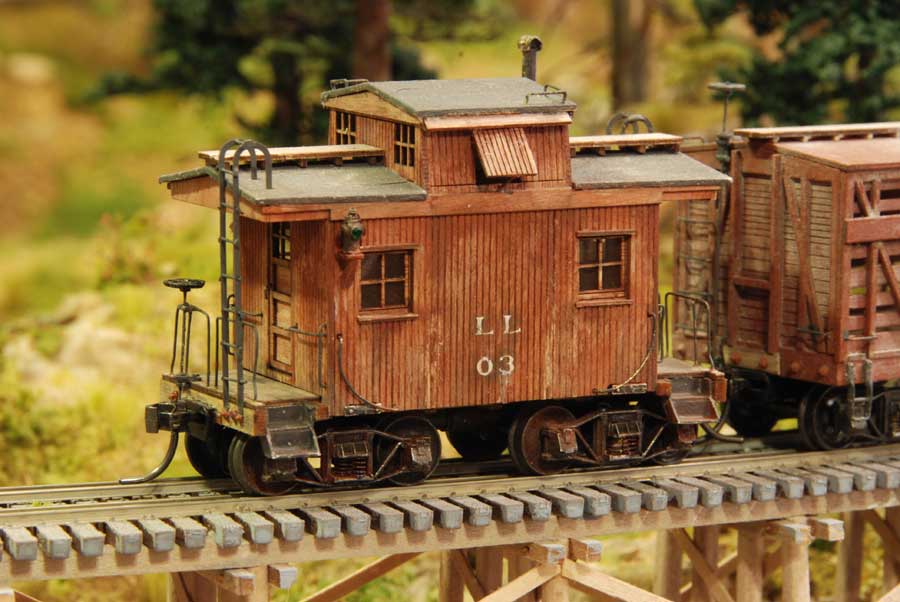
Logging
Caboose,
with a wash of
Oxide Red - from a Rio
Grande Models kit
Little Logging Railroad
LL Rolling Stock (HO)
D&RGW Rolling Stock (HOn3)
For a Spanish version by ChicksX

|
|
Logging
Caboose, |
The first thing I built were a couple of Kadee truss logging cars and their small industrial caboose. With some Kadee disconnected logging trucks, I also scratch-built a small water tank car, flat car for equipment, a sand car, and a small stock car for a team of horses. These cars were added to an already existing Colorado Midland boxcar I had built while in high school from a Central Valley kit. Along with a scratch-built gondola car and a greatly modified American Train and Track Tea Kettle 0-4-4, the boxcar are the only carry-overs from the HO diorama I had built over 40 years ago.
Boy, how much had changed with the rolling stock from the days of my high school diorama - new forms of couplers, non-magnetic trucks for the under the track magnetic uncouples, and, of course, DCC - running multiple trains independent of each other! So I did replace the trucks and couplers on the boxcar with Kadee products.
In early 2009 I began adding rolling stock from kits offered by Rio Grande Models - the Pickering Lumber Co. Caboose #2 (above), the Virginia & Truckee Outside Braced Ventilated Boxcar, the Yosemite Valley cattle car, the Virginia & Truckee baggage car, and a couple of Virginia & Truckee 24' Kimbal flatcars. Later in 2009 I added a Virginia & Truckee combination baggage and coach car. For the caboose and baggage car, I like the way the roofing turned out, using a thick covering of Tarnish Black and patting on a single layer of Kleenex tissue paper while wet; letting it dry and buffing it with some sandpaper, to give a "canvas look." I still am "challenged" when it comes to soldering, so the assembled ladders on the caboose are a little on the crude side. I added a couple of features to the caboose not part of the kit, the signal lights at the rear, a different smoke stack, a couple of grab irons to the cupola roof, and a few bolts in the end planks. I also had fun adding a little more detail to the doors of the ventilated boxcar - hinges, handles and lock. The deck of the flat cars were "stressed" a little, with an end board raised, a gap added between a couple of the boards, and a few nicks added here and there. For all these models I used Kadee #153 "scale" couplers (which have a slightly smaller head than the regular Kadee couplers and thus more authentic), brake wheels, and #551 arch bar trucks. The small brake staff ratchets (which anchors the brake staff to the body of the car) are from Tichy Train Group's Brake Wheel and Staff kit, and offer a nice touch of realism. The Rio Grande Models offers a product that is absolutely fun to build, with such detail and precision in the laser cut wood. But take your time, as the camera shows everything! I've got to work on my soldering.

|
|
Cattle car, with a dusting of "ash" - Rio Grande Models |
For painting of wood surfaces and metal parts, such as the harp switch stands and on the rolling stock, I've used Floquil Enamel and Polly Scale Acrylic colors. There is particularly a lot of use of the acrylic Tarnished Black, Oxide Red, Reefer Gray, and Reefer White, as well as enamel Grimy Black and Caboose Red, with some Rust, Brass and Old Silver applied were appropriate. For the Rio Grande Models' caboose, I made a wash of the Polly Scale Oxide Red and a little Reefer White, and then brushed some strikes of full-strength Reefer Gray and Oxide Red, to give an aged-faded look. For the Ventilated Boxcar I made a wash of Poly Scale Buff and brushes some strikes of the full-strength Buff. I did paint the roof with Oxide Red. I've had a lot of fun with Bragdon Enterprises Weathering System, applying the various colored powders to the rolling stock as well as to the buildings, and, as mentioned above, a little to the conifers. In the instance of the Rio Grande cattle car, once I had powdered the red surface (undiluted Oxide Red) with a little gray "ash" it gave the car the appearance of having just come out of a dust storm. So I take a piece of tape and dab it over much of the powdered surface, resulting in a more natural "blotchy" appearance, while keeping much of the dust in the recesses of the frame. Notice the unintended slight "sag" in the cattle car's roof; not bad for a accident! In all instances, a little buffing with a fine-grained sandpaper adds to the weathering process. And on the caboose and baggage car, with their very uniform vertical side boards, I "stressed" some of the siding with an X-acto knife, slightly increasing the gap between a few boards and giving a little "warping" to some of the boards.
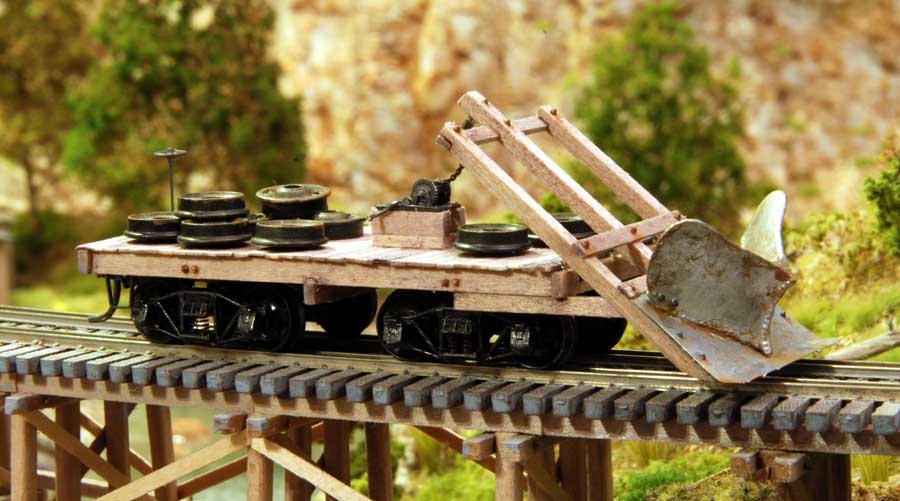
|
|
Snow
Plow, scratch-built, inspired by Bucker Snow Plow |
In September 2009 I tried my hand at another scratch-built car. Knowing the winters in timber country can be challenging but work continues, I needed some sort of snow plow. In The Modelers' Annual (Winter 2008 p.59) was an photograph and a wonderful diagram for a Bucker Snow Plow used on the Nevada Country Narrow Gauge RR. According to the provided notes, it was originally built in 1890, rebuilt in 1898 and nicknamed the "Cyclops," and sometime after 1940 retired. While a narrow gauge design, I figured my "shop" could build one for standard gauge use, adjusting the dimensions accordingly. I did purchase the upper plow piece, a Precision Scale Co "Colorado and Southern" snow plow, ordering it through Walthers. I used a hand-crank winch system to adjust the plow level. As was practiced, I added some freight wheels for ballast, but found the plow still a little light and derailing on me on a couple of places. So I added little lead under the body frame as well and we had the weight needed.
As of now I've used the dry transfer decals from Woodland Scenics for lettering, the LL, and numbering of the cars and locomotives. Once the decals are rubbed on, I spray on a thin coat of matt finish to help protect the lettering. Down the road, I may seek out a different style of lettering and numbering on the locomotives and rolling stock, perhaps working with Rail Graphics.
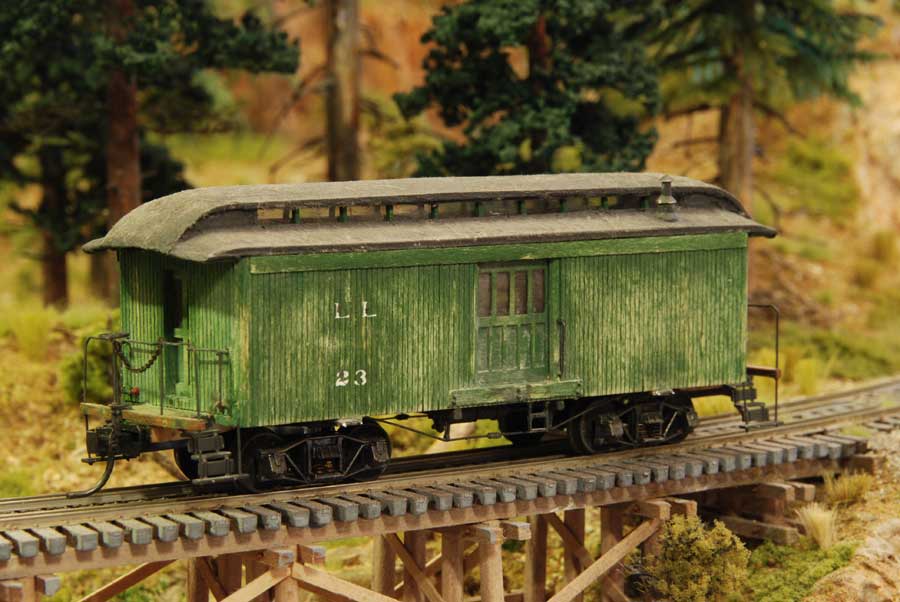 |
|
Baggage and mail car, with a little dusting and buffing - Rio Grande Models |
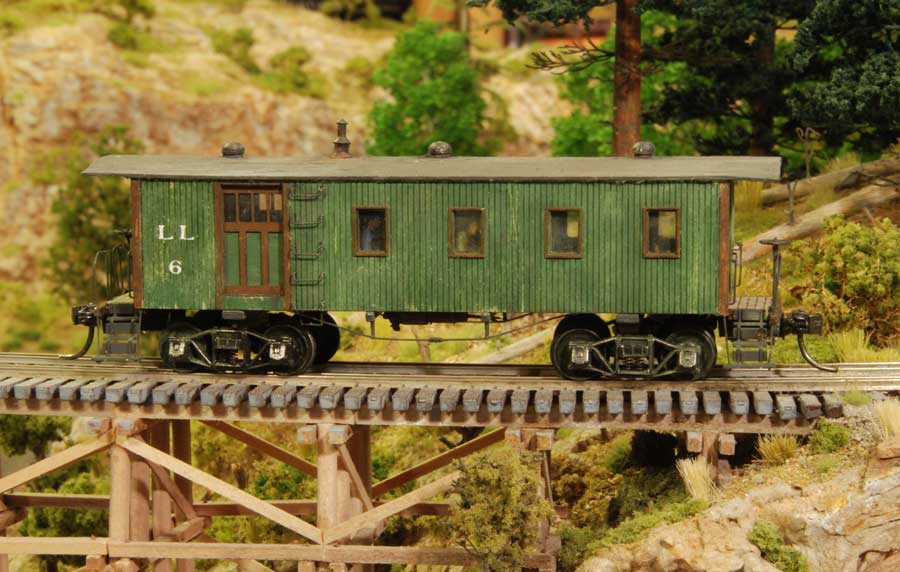 |
|
Baggage Coach Car - Rio Grande Models |
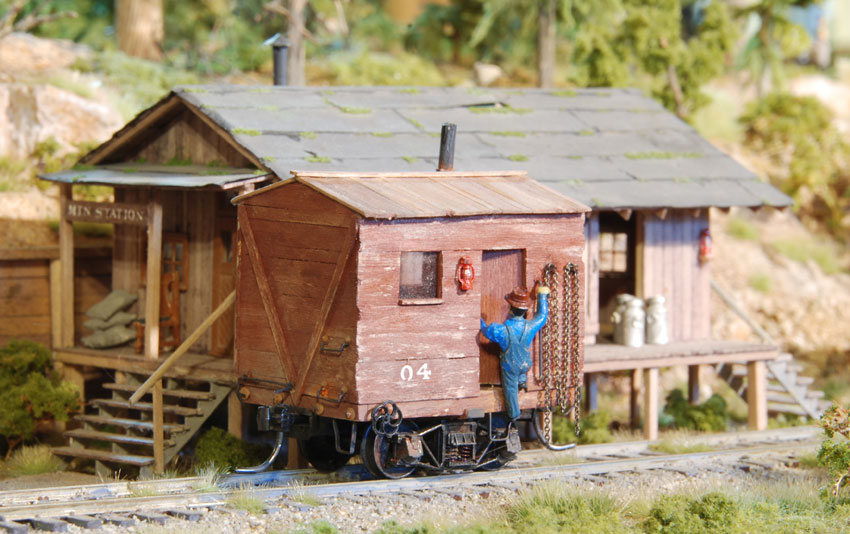 |
|
A little scratch-built "bobber." December 2012 |
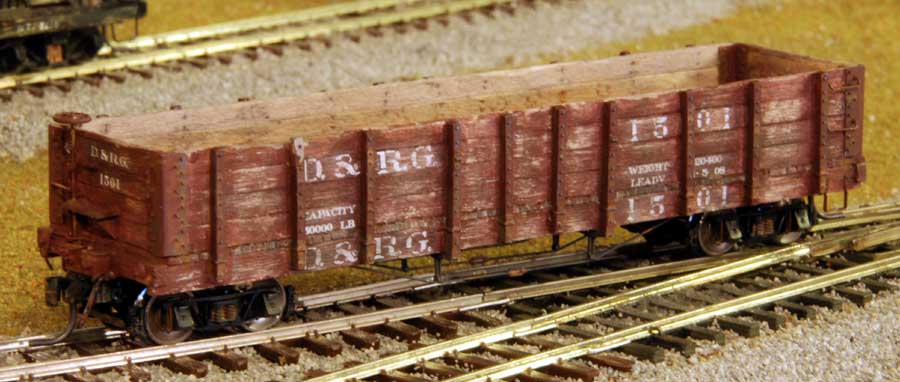 |
|
Narrow Gauge D&RG Gondola - Trout Creek Engineering See HOn3 |